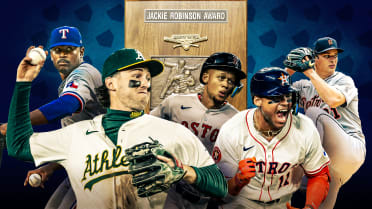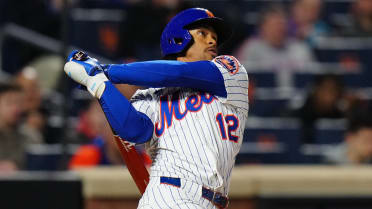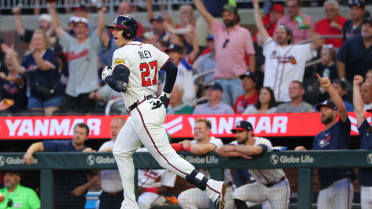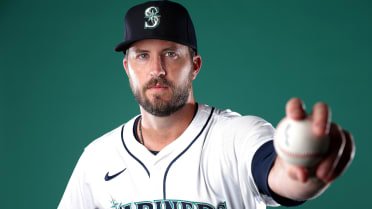It's the eighth inning of a tie game, and Aaron Judge walks up to the plate. Because Brett Gardner -- a left-handed hitter -- spent most of the season hitting in front of Judge, a lefty is on the mound. And because Judge is due up, the opposing manager strolls to the mound to replace said lefty. That's conventional wisdom, right? Bring in the righty reliever to face the righty slugger. Most of the time it works, and it's a strategy almost always adhered to.
But there are exceptions to every rule. Should you bring the righty in to face Judge? Every situation is different, but overall, Judge was actually less productive against left-handed pitching than he was against righties over the course of his emphatic American League Rookie of the Year Award-winning campaign.
Judge was one of the highest-profile players to demonstrate reverse platoon splits in 2017. Righties who hit righties better than lefties are tough to find, and lefties who hit lefties better than they hit righties are even odder still. Judge headlines a fascinating group.
In this story, we'll turn to Statcast™ to tell us what these hitters' peripherals can tell us about their reverse platoon splits. We'll look at the Statcast™ metrics expected batting average (xBA) and expected weighted on-base average (xwOBA), which use exit velocity and launch angle data to describe quality of contact and tell a larger story about the types of things hitters can control.
Aaron Judge, RF, Yankees
2017: Looking back, one of the strangest developments of this past season may have been how lefties kept Judge relatively in check. The biggest right-handed hitter in the game did most of his damage against right-handed pitching, mashing 44 of his 52 home runs and hitting .298/.417/.662. Against southpaws, he transformed into a more extreme three-true outcome hitter, slashing .230/.439./.496 and sacrificing 145 points of OPS.
Career: The only big league experience Judge has besides this past season was the 27-game cameo he made in September 2016. Judge famously struggled against all types of pitching then, striking out in 44 percent his plate appearances. But that was amplified against lefties then, too. Judge went just 1-for-15 (.067 average) against southpaws during his first cup of coffee.
What does Statcast™ say? Based on quality of contact, Judge underperformed expectations against southpaws in 2017, making him the victim of a 29-point difference between expected and actual batting average and 45 points between wOBA and xwOBA. The underlying data shows Judge was actually a better hitter against lefties (.456 xwOBA) than he was against righties (.443 xwOBA), hinting his decrease in production against southpaws could morph into a mirage going forward.
Michael Trout, CF, Angels
2017: Trout sported an unusual .280/.443/.463 line against southpaws this season, meaning he hit fine, reached base often but saw his power virtually disappear facing left-handed pitching. Trout hit 30 of his 33 home runs versus righties, while mashing .313/.441/.672, adding 206 points of overall OPS against pitchers who should be -- in theory -- tougher for him to hit.
Career: The splits aren't as extreme over the course of his career, but Trout's tendency to hit righties with more thump has been true since he debuted in the big leagues. Over seven seasons, Trout has reached base at the same exact rate (.410 OBP) against righties and lefties, but he has slugged 57 points higher opposing righties.
What does Statcast™ say? In Trout's case, these metrics back up his surface-level stats. Trout gained 48 points in xwOBA and 15 points in xBA against right-handers in 2017.
Corey Seager, SS, Dodgers
2017: Seager was the rare lefty with significantly better numbers against left-handed pitchers last season. He hit more than a third of his 22 home runs versus southpaws in 31 percent of his total plate appearances. Seager ranked third among lefties in batting average (.325) and weighted on-base average (.395) versus southpaws, and he gained 90 points of OPS against left-handers.
Career: In 2016, when the Dodgers as a team struggled mightily against lefties, Seager looked more like a typical lefty hitter: He saw his numbers decline sharply versus left-handed pitching (.250/.308/.413). But Seager reversed that script in '17, giving him two vastly different platoon profiles over his first two full big league seasons. So which is the real Seager? That remains to be seen. Seager, like Judge, is young enough that his career trends are yet to be defined.
What does Statcast™ say? Seager hit 28 points higher than his expected batting average, outperforming his quality of contact to a significant degree. The power, though, appears very real, as his xwOBA and wOBA against lefties nearly matched. In 2016, the numbers suggest Seager was a bit unlucky against lefties and fairly lucky against righties. All of this points to his future performance settling somewhere in the middle -- an improvement on his rookie skills but some regression from his bizarre '17 splits.
Yasiel Puig, RF, Dodgers
2017: Puig has actually spent time during his career platooning, playing mostly against lefties, which is interesting because he has often found more success versus righties. The 2017 season was the most extreme example of this. Puig did virtually all of his damage against right-handed pitching, hitting 26 of his 28 home runs. He became powerless against lefties, batting .183 with a higher on-base percentage (.317) than slugging percentage (.275).
Career: The erratic nature of Puig's career production mirrors his career platoon splits. Some years, he mashes left-handed pitching. Others, Puig goes completely cold against southpaws. It evens out somewhat, but he still adds 59 points of OPS against righties over five seasons.
What does Statcast™ say? Puig lost almost 40 points of expected batting average against lefties, which metrics say is underperforming by a pretty wide degree. This could happen for a variety of reasons, including variance, batted-ball "luck" and other factors. Couple that with the fact that Puig gained 23 points against righties due to some probable good fortune (.265 xBA), and you get his extreme 2017 season.
Adam Jones, CF, Orioles
2017: No active player has maintained such extreme reverse splits for as long as Jones, who has hit righties better than lefties consistently throughout his 12-year career. Last season was par for the course in this regard: Jones batted .293/.322/.481 against righties and .260/.321/.418 against lefties.
Career: Something weird happened in 2014, when Jones suddenly started mashing lefties to the tune of a 1.003 OPS. That sudden spike proved to be a one-year aberration, though. He hit righties better every year before, and he has every year since. Over his career, Jones enjoys a 66-point bump in OPS against same-side arms.
What does Statcast™ say? Jones' reverse splits last season were a bit of an illusion: He actually made better contact against lefties according to xwOBA, and he managed essentially identical xBA numbers against righties and lefties. Zoom out a bit, though, and the metrics reflect Jones' career trends. The center fielder has benefited from 42 added points of xwOBA against righties since Statcast™ began tracking in 2015.
Trea Turner, SS, Nationals
2017: Against righties, Turner shows all the traits of an elite modern leadoff hitter. He can hit, he can run, he can be patient and he can hit for power. But against lefties, Turner devolves into a leadoff hitter from an earlier era: still lots of speed but very little power. He found virtually no success against southpaws in 103 plate appearances this past season, hitting .245/.311/.319 without any home runs. Against righties, Turner's .296/.346/.491 slash line with 11 homers and 40 stolen bases screamed five-tool talent.
Career: Turner's preference to face righties isn't something new. All but one of his 25 career home runs have come against right-handed pitching. Turner's OPS gets a 198-point boost against righties.
What does Statcast™ say? wOBA and xBA might not be the best tools by which to evaluate Turner, whose speed allows him to often outperform some below-average quality of contact. Instead, we'll turn to hard-hit rate, which measures how often a batter hits the ball with an exit velocity upwards of 95 mph. Turner's plummeted last season -- from 41 percent against righties to 32.5 percent against lefties. It's a difference similar to the one Anthony Rizzo, a left-handed hitter, more predictably saw. Interestingly, Trout also endured a nearly identical drop.
Joe Trezza is a reporter for MLB.com based in New York. Follow him on Twitter at @joetrezz.



